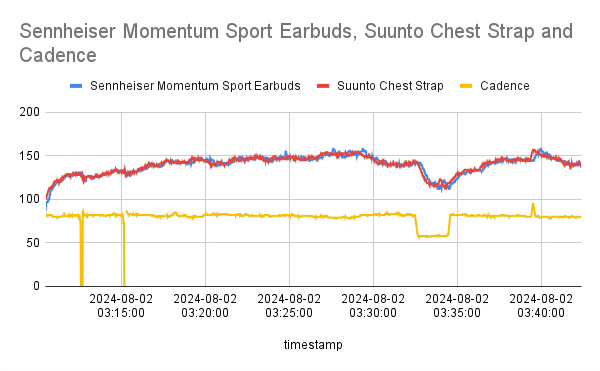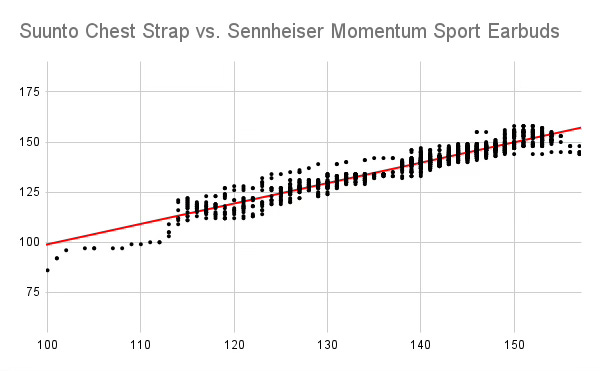Follow-up test with the Sennheiser Momentum Sport Earbuds
Post firmware update to 3.18.43
In April this year, I wrote about a run comparing the Senheiser Momentum Sport Earbuds to a Polar chest strap while running. The performance wasn’t satisfactory.
They're not the cleanest, but even without formatting one can see how erratic the Sennheiser headphones are. Quantified, there's a correlation of 0.82 between the two series.
Since then, I returned the original pair I bought, and waited for a pair to come up more cheaply on Amazon Warehouse. They did, and I bought them at a more agreeable price ($150, I think). On the weekend of 2024-wk30, I found myself running with my phone, and as there had been a firmware update promising the following, I took the opportunity to test their claims.
New body temperature algorithm with improved accuracy
Improved in-ear and out-of-ear detection
Heart rate and body temperature bug fix
Minor improvements & bug fixes
As with last time, there’s no way to export the body temperature, and I wasn’t wearing my CORE so I had nothing to compare it to, but as the headphones suggested that, after a 15m max-effort test, my body temperature was 36.4º, I’m going to skip that as it’s clearly not capable of inferring my body temperature from my ear.
Test Setup
Suunto Vertical, recording from a Suunto Chest Strap
iPhone 15 Pro Max, recording from the headphones with the Polar app
I recognise this is different to last time, where it was a Polar chest strap and a Garmin recording, but I don’t believe the difference is significant.
Data Processing
This was a pain in the arse, but with the help of GoToes, awk and sed, I had a nice sheet to analyse:
I have cadence shown, as the previous firmware release had a problem with cadence lock, where the algorithm incorrectly identifies vibration from my running cadence as HR.
There are some obvious discrepancies, but it looks like they’ve solved their cadence lock problem, which is good.
Removing the cadence from the chart, and chanting to a scatter plot with a trend line, the spread becomes more apparent:
I started this write-up with a quote from my previous post on the subject citing the correlation of 0.87 between the values. On this run, after the firmware update, the correlation has improved massively, to 0.97. Looking at the discrepancies in the data, I still wouldn’t want to use these for running, but it’s a huge improvement. I hope with another firmware update they can increase the correlation to 0.99, at which point they’d be interesting for running.
As it stands, I think they’re fine for cycling, and probably climbing, but until I’m fully out of repair mode following a recent spontaneous uncontrolled dismount from my velocipede at the hands of a motor car, that testing will have to wait.
Update 2024-08-03
I ran with the same setup again, I’ll skip the meta, here are the results:
Correlation: 0.96
Update, 2024-08-04
Compared with Polar Verity Sense
Same setup as above, but swapping the Suunto chest strap for a PVS, produced a correlation of 0.98. The PVS was on my upper-right bicep, with the watch on my right wrist. Charts drawn with ChatGPT.
Comparing the two HR monitors, with cadence recorded from Stryd pods in the blue plot.
Another scatter plot.
Summary
When I first used the headphones, the correlation was 0.82 with the chest strap I was wearing. There was a clear cadence lock issue, and the HR data was as useful as a chocolate teapot. One firmware update and a few months later, I think that they’re decent, with an average correlation of 0.97 over three runs.
Body Temperature Addendum
Still useless. On the second run, they showed me cooling down, not warming up over 32m. I wish I’d had the CORE on, but it just seems wildly improbable that my core temperature decreased during a run in a humid 19º…







